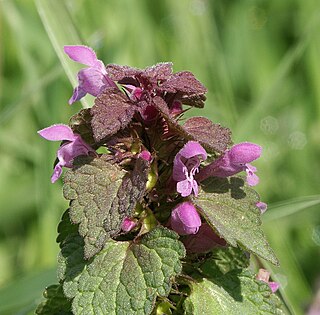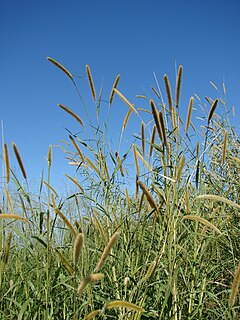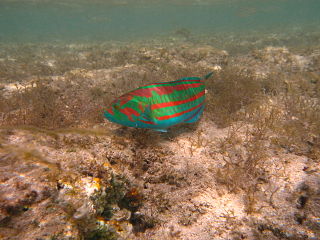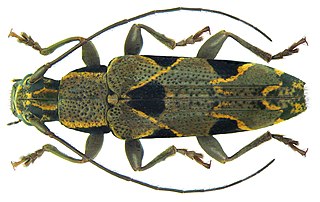
Lamium purpureum, known as red dead-nettle, purple dead-nettle, purple archangel, or velikdenche, is a herbaceous flowering plant native to Europe and Asia.

Pennisetum purpureum, also known as Napier grass, elephant grass or Uganda grass, is a species of perennial tropical grass native to the African grasslands. It has low water and nutrient requirements, and therefore can make use of otherwise uncultivated lands. Historically, this wild species has been used primarily for grazing; recently, however, it has been used as part of a push–pull agricultural pest management strategy. This technique involves the desired crop being planted alongside a 'push' plant, which repels pests, in combination with a 'pull' crop around the perimeter of the plot, which draw insects out of the plot. Napier grass has shown potential at attracting stemborer moths away from maize and hence is the "pull" crop. This strategy is much more sustainable, serves more purposes and is more affordable for farmers than insecticide use. In addition to this, Napier grasses improve soil fertility, and protect arid land from soil erosion. It is also utilized for firebreaks, windbreaks, in paper pulp production and most recently to produce bio-oil, biogas and charcoal.

Silver leaf is a fungal disease of trees caused by the fungus plant pathogen Chondrostereum purpureum. It attacks most species of the rose family Rosaceae, particularly the genus Prunus. The disease is progressive and often fatal. The common name is taken from the progressive silvering of leaves on affected branches. It is spread by airborne spores landing on freshly exposed sapwood. For this reason cherries and plums are pruned in summer, when spores are least likely to be present and when disease is visible. Silver Leaf can also happen on poming fruits like apples and pears. Plums are especially vulnerable.

Helicobasidium purpureum is a fungal plant pathogen which causes violet root rot in a number of susceptible plant hosts. It is synonymous with Helicobasidium brebissonii (Desm.) Donk. It is the teleomorph of Tuberculina persicina which is its mycoparasitic anamorph.

Eutrochium purpureum, commonly known as purple Joe-Pye weed, kidney-root, sweetscented joe pye weed, sweet Joe-Pye weed, gravel root, or trumpet weed is an herbaceous perennial plant in the sunflower family. It is native to eastern and central North America, from Ontario east to New Hampshire and south as far as Florida, Louisiana, and Oklahoma.
Purpureum, purple in Latin, may refer to:

Chlorogalum purpureum is a species of flowering plant related to the agaves known by the common name purple amole.

Calostemma is a small genus of herbaceous, perennial and bulbous plants in the Amaryllis family, commonly known as Wilcannia Lily. It consists of three species endemic to Australia, where they are distributed in arid regions with summer precipitation.

The surge wrasse, Thalassoma purpureum, is a species of wrasse native to the southeast Atlantic Ocean through the Indian and Pacific Oceans, where it inhabits reefs and rocky coastlines in areas of heavy wave action at depths from the surface to 10 m (33 ft). It can grow to 46 cm (18 in) in total length and 1.2 kg (2.6 lb) in weight. This species is of minor importance to local commercial fisheries, is popular as a game fish, and can be found in the aquarium trade.
C. purpureum may refer to:

Phenylethanoids are a type of phenolic compounds characterized by a phenethyl alcohol structure. Tyrosol and hydroxytyrosol are examples of such compounds.
Dipodium purpureum is an orchid species that is native to Borneo. The species was formally described in 1910 by Dutch botanist Johannes Jacobus Smith.

Geranium purpureum, the little-robin, is a species of plant in the genus Geranium.
Xanthophyllum purpureum is a plant in the family Polygalaceae. The specific epithet purpureum is from the Latin meaning "purple", referring to the flowers.

Tmesisternini is a tribe of beetles in the subfamily Lamiinae containing the following genera:
Blapsilon is a genus of longhorn beetles of the subfamily Lamiinae, containing the following species:
Blapsilon austrocaledonicum is a species of beetle in the family Cerambycidae. It was described by Xavier Montrouzier in 1861, originally under the genus Lamia. It is known from New Caledonia. It feeds on Araucaria laubenfelsii.
Blapsilon irroratum is a species of beetle in the family Cerambycidae. It was described by Francis Polkinghorne Pascoe in 1860. It is known from New Caledonia.
Blapsilon montrouzieri is a species of beetle in the family Cerambycidae. It was described by James Thomson in 1865. It is known from New Caledonia.
Blapsilon viridicolle is a species of beetle in the family Cerambycidae. It was described by Chevrolat in 1858, originally under the genus Tmesisternus. It is known from New Caledonia.












